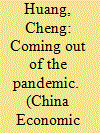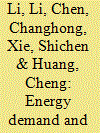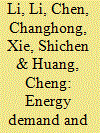|
|
|
Sort Order |
|
|
|
Items / Page
|
|
|
|
|
|
|
| Srl | Item |
| 1 |
ID:
192379


|
|
|
|
|
| Summary/Abstract |
In this editorial, we reviewed the articles collected in the special issue “Economics of Pandemic Disease” along with other relevant literature. We found that the pandemic has had a devastating impact on the economy as a whole and on small and medium-sized enterprises (SMEs) and private firms in particular, which may have deepened the economic inequality and impeded poverty reduction in China. The pandemic also resulted in substantial damage to the mental health and well-being of the Chinese population, with a disproportionate impact on minorities, including the female and the illiterate. We also examined the available evidence regarding the effectiveness of China's policy response to the COVID pandemic, which suggested that China's zero-Covid policy succeeded in stabilizing its economy and maintaining a safe environment in earlier phases of the pandemic, but hardly achieved a balance between disease control and economic growth in the later stage when less fatal but more transmissive coronavirus variants emerged. Lastly, we discussed policy options that China may take to protect the health of its people and avoid a potentially substantial loss of lives during the transition toward the post-pandemic new normal, which include prioritizing the timely administration of effective vaccines among the elderly and vulnerable populations, improving public communications regarding when and how to seek medical help, and strengthening the surge capacity of the healthcare systems, especially in less developed regions.
|
|
|
|
|
|
|
|
|
|
|
|
|
|
|
|
| 2 |
ID:
192381


|
|
|
|
|
| Summary/Abstract |
In this editorial, we reviewed the articles collected in the special issue "Economics of Pandemic Disease" along with other relevant literature. We found that the pandemic has had a devastating impact on the economy as a whole and on small and medium-sized enterprises (SMEs) and private firms in particular, which may have deepened the economic inequality and impeded poverty reduction in China. The pandemic also resulted in substantial damage to the mental health and well-being of the Chinese population, with a disproportionate impact on minorities, including the female and the illiterate. We also examined the available evidence regarding the effectiveness of China's policy responses to the COVID-19 pandemic, which suggested that China's zero-Covid policy succeeded in stabilizing its economy and maintaining a safe environment in earlier phases of the pandemic, but hardly achieved a balance between disease control and economic growth in the later stage when less fatal but more transmissive coronavirus variants emerged. Lastly, we discussed policy options that China may take to protect the health of its people and avoid a potentially substantial loss of lives during the transition toward the post-pandemic new normal, which include prioritizing the timely administration of effective vaccines among the elderly and vulnerable populations, improving public communications regarding when and how to seek medical help, and strengthening the surge capacity of the healthcare systems, especially in less developed regions.
|
|
|
|
|
|
|
|
|
|
|
|
|
|
|
|
| 3 |
ID:
182728


|
|
|
|
|
| Summary/Abstract |
According to Chinese astrology, each lunar year is symbolized by a zodiac animal, including the Dragon, which represents auspiciousness, power and greatness. Based on high-quality administrative data from birth certificates in Shenzhen, China, we first show that a considerable number of births are shifted from one week before the Dragon year to one week after the Dragon year begins, mainly through vaginal and elective C-sections. Then, we estimate the causal health effects of delaying births but do not find any significant results, as measured by birth weight, Apgar scores, and neonatal mortality.
|
|
|
|
|
|
|
|
|
|
|
|
|
|
|
|
| 4 |
ID:
098210


|
|
|
|
|
| Publication |
2010.
|
| Summary/Abstract |
In this paper, Shanghai's CO2 emissions from 1995 to 2006 were estimated following the IPCC guidelines. The energy demand and CO2 emissions were also projected until 2020, and the CO2 mitigation potential of the planned government policies and measures that are not yet implemented but will be enacted or adopted by the end of 2020 in Shanghai were estimated. The results show that Shanghai's total CO2 emissions in 2006 were 184 million tons of CO2. During 1995-2006, the annual growth rate of CO2 emissions in Shanghai was 6.22%. Under a business-as-usual (BAU) scenario, total energy demand in Shanghai will rise to 300 million tons of coal equivalent in 2020, which is 3.91 times that of 2005. Total CO2 emissions in 2010 and 2020 will reach 290 and 630 million tons, respectively, under the BAU scenario. Under a basic-policy (BP) scenario, total energy demand in Shanghai will be 160 million tons of coal equivalent in 2020, which is 2.06 times that of 2005. Total CO2 emissions in 2010 and 2020 in Shanghai will be 210 and 330 million tons, respectively, 28% and 48% lower than those of the business-as-usual scenario. The results show that the currently planned energy conservation policies for the future, represented by the basic-policy scenario, have a large CO2 mitigation potential for Shanghai.
|
|
|
|
|
|
|
|
|
|
|
|
|
|
|
|
| 5 |
ID:
098540


|
|
|
|
|
| Publication |
2010.
|
| Summary/Abstract |
In this paper, Shanghai's CO2 emissions from 1995 to 2006 were estimated following the IPCC guidelines. The energy demand and CO2 emissions were also projected until 2020, and the CO2 mitigation potential of the planned government policies and measures that are not yet implemented but will be enacted or adopted by the end of 2020 in Shanghai were estimated. The results show that Shanghai's total CO2 emissions in 2006 were 184 million tons of CO2. During 1995-2006, the annual growth rate of CO2 emissions in Shanghai was 6.22%. Under a business-as-usual (BAU) scenario, total energy demand in Shanghai will rise to 300 million tons of coal equivalent in 2020, which is 3.91 times that of 2005. Total CO2 emissions in 2010 and 2020 will reach 290 and 630 million tons, respectively, under the BAU scenario. Under a basic-policy (BP) scenario, total energy demand in Shanghai will be 160 million tons of coal equivalent in 2020, which is 2.06 times that of 2005. Total CO2 emissions in 2010 and 2020 in Shanghai will be 210 and 330 million tons, respectively, 28% and 48% lower than those of the business-as-usual scenario. The results show that the currently planned energy conservation policies for the future, represented by the basic-policy scenario, have a large CO2 mitigation potential for Shanghai.
|
|
|
|
|
|
|
|
|
|
|
|
|
|
|
|
|
|
|
|
|